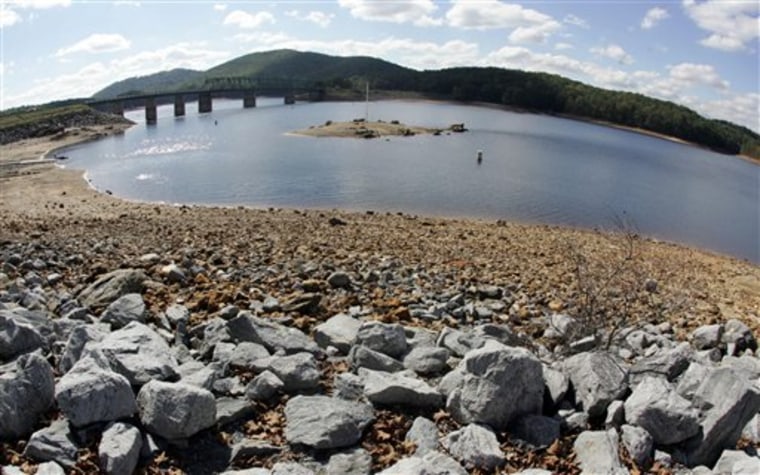According to officials in the state of Georgia, one solution to a drought gripping the normally soggy U.S. Southeast is to take up the battle cry of "man versus mussel."
Gov. Sonny Perdue says the U.S. Army Corps of Engineers has been allowing Georgia's water to flow to endangered mussels and other species in Florida and thereby preventing state residents from sprinkling their yards and hosing down their cars.
"I'm telling you, when it comes to choosing between mussels and drinking water for children, I'm about fed up with this mess," Perdue said after declaring an emergency this month as Atlanta's main source of water dropped to what the state said was a 90-day supply.
Environmentalists and water use experts say Georgia's water woes weren't caused by any endangered species.
The drought plaguing parts of at least seven U.S. states in the Southeast has to do with exploding demand in some of the fastest growing areas of the United States, breakneck urban development that has paved over acres of natural wetlands, and poor planning by local authorities.
"It's very misleading when the debate is framed as people versus mussels," said Gil Rogers, a staff attorney in Atlanta for the Southern Environmental Law Center.
What politicians in the Southeast need to do is to look at the way "we're growing and whether there is water to maintain the lifestyle we all want," Rogers said. "Our political leadership has blinkers on when it comes to anything that might get in the way of unrestricted development."
U.S. a water hog
Americans are among the largest consumers of water on the planet, as they are of oil and other natural resources. The average American uses 373,900 gallons of water a year, seven times as much as the average Briton.
With climate change looming, Americans will have to adapt to a world with less water, experts say.
A 2003 report by the U.S. Government Accountability Office found that 36 U.S. states expected to suffer water shortages in the subsequent decade.
"These kind of extreme droughts are wake-up call moments," said Monty Schmitt, a senior water resources scientist with the Natural Resources Defense Council. "(Climate change) is going to make a tough situation even tougher."
Streets will have to be swept, not washed with hose pipes; potable water may have to be restricted for drinking and cooking only and recycled water used outdoors; gardeners might have to tear out their favored rose bushes and replace them with less thirsty plants. And water companies will have to plug the leaks in their pipes that can account for up to 25 percent of the water used in many communities.
"The challenges are different in different parts of the country, but fundamentally it's about getting the mindset that water doesn't just come out of faucets," said Chris Brown, director of the California Urban Water Conservation Council.
"For the longest time we have tended to deal with water as a commodity ... if we produce more of it we can sell more of it ... and not as natural resource that needs to be managed."
Wettest areas least concerned
Californians and residents of other dry southwestern U.S. states have had to learn to manage their water as a precious resource, said Brown.
But Georgia and other states in the Southeast — the wettest areas of the United States — have done little about water conservation.
"It hasn't been a hot button issue," said James Heaney, a professor and chair of the Department of Environmental Engineering Sciences at the University of Florida.
Before declaring an emergency, the only serious measure adopted in Georgia to fight the drought was a ban on outdoor watering in the northern part of the state. Industrial car washes, golf courses and industry were exempt.
A plan drawn up in 2003 to manage water better in the Atlanta metropolitan area has been paid little heed. Similarly, a proposal presented last year to state lawmakers that would have required old homes to be retrofitted with water efficient toilets when sold never went anywhere.
"The realtors killed the proposal," said Rogers.
Ultimately, environmentalists say Georgia's slow stumble into an acute water crisis was not inevitable.
In the first 10 months of the year, Atlanta and the surrounding areas where up to 4 million people live have received 20 inches of rain, half their usual amount.
Mexico City, with a population of 18 million, makes do on 25 inches in an entire year. California, on average, gets 18 inches of rain per year.
But the land in the urban U.S. Southeast is increasingly unable to act as a sponge to store the rainfall as it disappears beneath concrete and tarmac. Around 55 acres are paved over in Atlanta each day, environmentalists say.
"Development has taken the place of the natural order. We have lost innumerable wetlands to shopping malls and suburbs," said Cat McCue of the Southern Environmental Law Center.
